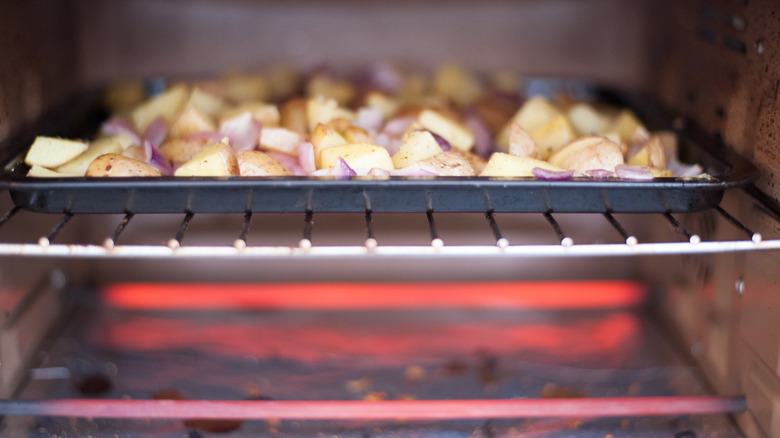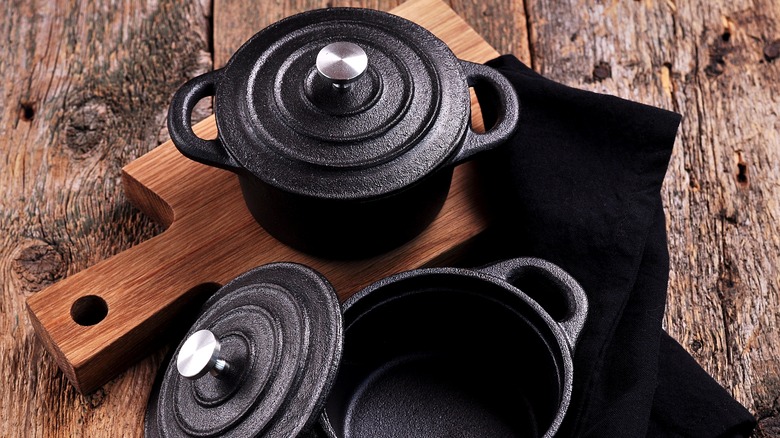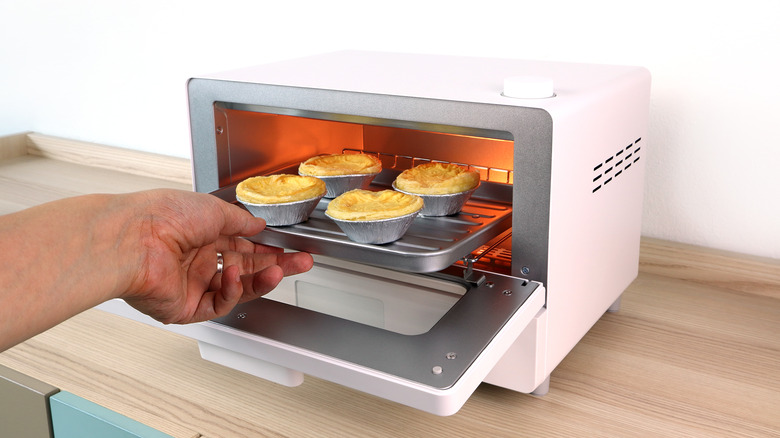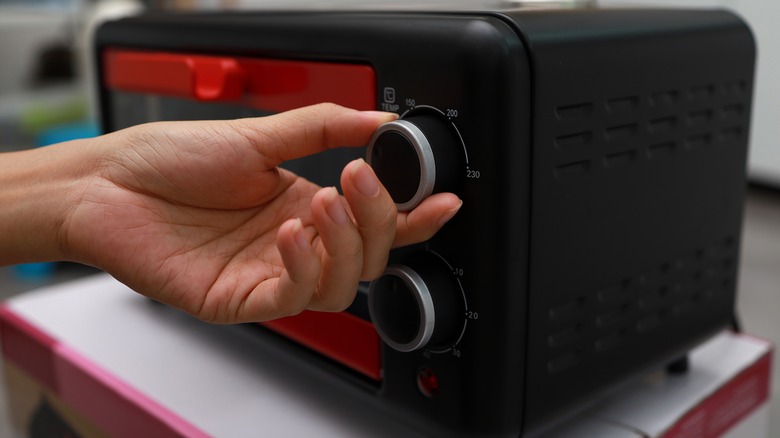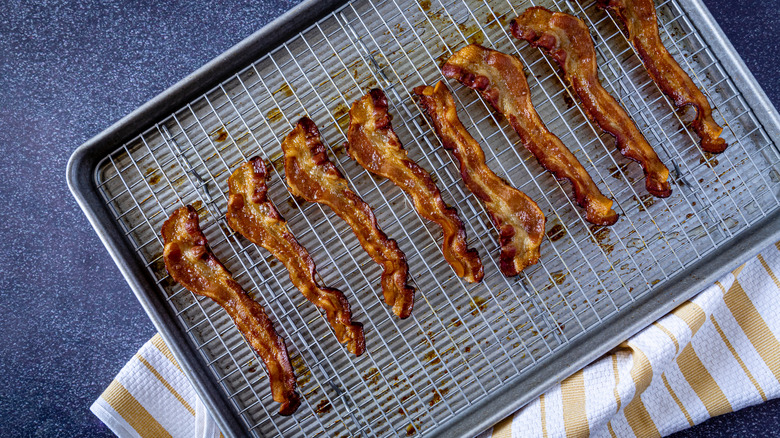Tips You Need When Cooking With A Toaster Oven
We may receive a commission on purchases made from links.
If you regularly cook at home for one or two people, you should make a toaster oven your feeding-time workhorse. A toaster oven is perfectly capable of cooking many different things. It's probably best used for roasting side dishes, like potato wedges, asparagus, or chopped vegetables. However, toaster ovens are also a low-maintenance method when cooking bacon, which you can later use in sandwiches and breakfast wraps. While it takes a bit of finesse, a toaster oven can also be used to bake pizzas, cookies, and even cakes.
According to Unclutterer, one of the great benefits of a toaster oven is that it heats up faster than a regular oven, making it a speedier way to bake or broil. A toaster oven also throws less heat into the surrounding kitchen (or dorm room), making it ideal for warm-weather cooking. While a microwave also offers these advantages, it cannot produce the same crispy and crunchy textures as a toaster oven. This countertop cooking gadget is very similar to conventional ovens in the ways that count most. However, there are a few special considerations and tips you must keep in mind when using a toaster oven.
Keep It Clean
If you are using your toaster oven regularly, you are likely accumulating crumbs, burnt bits, gunk, schmutz, and who knows what else in the bottom tray. Periodically cleaning this tray and the rest of the oven not only avoids burning aromas every time the oven heats up but it also avoids a potential fire hazard.
Good Housekeeping recommends that you start cleaning your toaster oven by — and this is important — making sure it's unplugged. Next, remove the crumb tray and any racks or pans. Take the oven over to your trash can, open the door, and shake out any loose bits of food. Wash all removable oven parts with soapy water, using an abrasive cloth or sponge to remove crusted-on food. Wet a sponge with a homemade oven cleaner made from vinegar, warm water, and a few drops of dish soap, and use it to clean the inside of the oven (via Consumer Reports). Wiping the exterior is also important for reducing dust that may clog vents or fans. With a wet cloth, wipe the oven to remove any cleaner. Rinse the removable parts. Allow the oven and its components to dry completely before using it again.
Practice Toaster Oven Safety
One of the biggest drawbacks of a toaster oven is that the exterior gets hot, very hot (via Hunker). A toaster oven is also an electrical appliance, and as such, it needs to be handled with electrical safety in mind too.
You may not be in the habit of doing it, but the U.S. Consumer Product Safety Commission recommends unplugging your toaster oven. Toaster ovens have been recalled by the CPSC for being a potential fire hazard. Some have been known to spontaneously turn on or fail to switch off at the end of a cook cycle, and Hunker writes that high temperatures can cause the glass to shatter. You should also avoid using a toaster oven near a sink, or any water for that matter. Regularly inspect your toaster oven and its cord for any damage.
In addition to electrical safety, it's also important to think about fire and burn safety. Before using the oven, make sure any heat-sensitive or readily flammable objects are at least three feet away. Never leave a hot oven unattended, and always keep an eye on young children when using a toaster oven. One additional tip is to consider purchasing a toaster oven with an exterior made from cool touch materials, which Inverse says can reduce the risk of burns.
Use Toaster Oven Cookware
Most toaster ovens come with a cute little metal tray, and while that may be adequate for various uses, you should know that there is a whole world of toaster oven cookware out there (via the Brilliant Kitchen). Durable, enamel-covered stoneware is perfect for baking, roasting, and broiling and will make the most of your very tight space. Small pizza stones and muffin pans are great for their intended purpose, but home cooks can use them to make a lot more than their namesakes might suggest, like this New York Times recipe for popover pastry. A mesh crisper mat is good for crusting up fries or chicken nuggets. A toaster oven tray and rack, which allows rendered fat to drip down safely, is ideal should you need to cook meat.
If you are going to use the standard mini tray, swapping silicone mats for parchment paper is a great way to prevent food from sticking, and they avoid the waste that comes from single-use products. Make sure any cookware you use in a toaster oven allows for adequate airflow, especially when convection cooking. In our perspective, ½-inch or more on either side of a pan facilitates more even cooking.
Use Correct Positioning
Being a lot roomier than a toaster oven, the conventional oven allows for a good flow of hot air, which is an essential part of roasting or baking. Therefore, it is important to allow for an optimal airflow when using a toaster oven. This involves choosing the right pan, using the ideal rack positioning, and tactically arranging your food.
To avoid uneven cooking, use pans that do not contact the sides of the oven or the heating elements. If you are using the convection fan, use a pan with low sides, allowing hot air to flow over your food. According to Consumer Reports, it's also a good idea to use light-colored baking pans because dark pans can quickly transfer heat from a toaster oven's close-proximity heating elements, increasing the chances of burning.
Users should always center pans on a rack, and the rack itself should be positioned in the middle of the oven, except when toasting or broiling with direct heat. If your toaster oven has two racks and you are using them simultaneously, be sure to rotate the pans about halfway through the cooking time.
Consider Time and Temperature When Convection Cooking
Many toaster ovens have a convection fan that circulates the air generated by the heating elements. CNET reports that switching on the convection oven fan can cook food faster and more evenly, thanks to a constantly shifting airflow. But, because most baking and roasting recipes are written with a standard oven in mind, you'll have to make changes to the time and temperature.
If your toaster oven doesn't automatically adjust its settings for convection cooking, you should take the temperature called for by your recipe and reduce it by 25 degrees Fahrenheit. Also, it's a good idea to check your food about half to three-fourths of the way through your cook time to see if a shorter cooking period is required. In addition to adjusting your temperature and time, you should ensure your food gets enough airflow. Use low-sided pans, ensure there's enough space between multiple items, and don't cover when convection cooking (via The Washington Post).
It's also a good idea to consult your manual with respect to rack location. If the manual does not specify, the middle or bottom rack location is typically best. If you are cooking with multiple racks, pan rotation is recommended (via Toaster Oven Love).
Make Adjustments to Baking Recipes
If you're baking for just one or two people, it might make more sense to use a toaster oven rather than a conventional oven. However, successfully baking a small cake or handful of cookies in a toaster oven will require a few adjustments. Every oven has hot spots, but the temperature difference between locations in a toaster oven can be significant. Before you start working on any baking recipes, you should figure out the hottest locations in your toaster oven. You can do this by toasting bread in every part of the oven and looking at the brownness of each slice (via King Arthur Baking). Once you know the hot spots, you can position and rotate your dish accordingly.
It's also important to have a small pan that doesn't come in contact with the heating elements. Be sure to adjust your recipe for the size of your pan. Until you get comfortable with the quirks of your particular model, check on cake, cookies, or other baked goods regularly. Toaster Reporter makes the case to get precise by using an oven thermometer, which can ensure your appliance is heating correctly and give you the data for exact temperatures. It may take a few times to get a feel for it, but baking in a toaster oven is a skill worth learning.
Watch Carefully when Dehydrating
Whether you want to dehydrate garlic to make garlic powder or orange wheels for cocktails, a toaster oven is a quick and easy way to get it done without occupying your main oven for several hours (via Dehydrator Lab). In addition, toaster ovens tend to have lower temperature settings than conventional ovens, which is ideal for dehydrating. Some of the best foods to dehydrate, according to Rogue Preparedness, include garlic, citrus fruits, berries, and stone fruit.
Start by collecting essential items: a flat toaster oven pan, parchment paper, a sharp knife or mandolin, and a spatula. If you're dehydrating fruits that brown when exposed to oxygen, like apples, you'll want to have lemon juice on hand. Cut your food into thin slices. Dip oxidizing fruit slices in lemon juice and shake off excess. Place the pieces in a pan lined with foil or parchment paper. Then, place your toaster oven at the lowest temperature setting, ideally between 120 and 150 degrees Fahrenheit. If the oven has a convection fan, switch it on.
Occasionally flip your food to ensure even dehydration and avoid burning. Keep an eye on the temperature and open the door if the temperature spikes. Leaving the oven door slightly ajar can also help to avert temperature spikes. Because staying within the ideal temperature range is critical, you may want to use an oven thermometer.
Regularly Check Oven Temperature
There are a number of reasons why your toaster oven may not be able to sustain the temperature to which you've set it, such as faulty heating elements or a broken temperature selector (via Wirecutter). Because they can be unreliable, it's a good idea to monitor your toaster oven's temperature while in operation regularly. Using an oven thermometer, start by checking your oven's preheat cycle. While some ovens signal the end of preheating with a light signal or beep, it's good to know if the oven has properly preheated.
Once you've got a sense of preheating accuracy, you should review if your oven properly maintains the right temperature through the duration of a cook cycle. The Toaster Oven Love suggests an experiment using a minimum cook time of one hour and recording the temperature every 15 minutes. At the end of the cooking time, average your recorded temperatures, and you should have a sense of your oven's fidelity. While most ovens don't allow you to recalibrate temperature settings, knowing the accuracy of your oven can help you mitigate any inaccuracies or know if it's time for an upgrade.
Use Tongs, Not Fingers
Your high diving or skateboarding days may be over, but the daredevil inside you can still out when it's time to yank something out of the toaster oven. Rather than burning your sensitive, well-manicured little fingers, try using tongs that have been specially designed for toaster ovens. One of the best ways to avoid burning your fingers while steering clear of any electrical issues is to use small bamboo toaster tongs, as recommended by Southern Living. Available in sizes less than 10 inches long, bamboo tongs are small and maneuverable enough to pick out broken toast or food pieces. They're also a handy way to manipulate food in non-stick pans, which you'll want to avoid scratching at all costs.
If sticking your hand into a hot oven isn't your thing, but neither is using tongs, you could use a rack puller, a tool made to pull hot racks out of an oven (via Foods Guy). Avoid buying a mostly frivolous device that occupies space in your utensil drawer by picking up a rack puller that can double as a kitchen ruler or set of tongs.
Take Advantage of Versatility for Essential Components
Cooking bacon, tostadas, or croutons from scratch can be a messy ordeal. Still, the versatility of many toaster oven creations allows for cooking these essential meal components without pan-frying, deep-frying, or conventional baking, respectively.
Cooking bacon in a toaster oven is mostly a set-it-and-forget-it affair. Preheat your oven to 400 degrees Fahrenheit, lay strips of bacon in a pan, and put it in the oven for 15 minutes. If you have a rack pan, it allows the bacon to crisp and excess grease to collect in the pan. Lining your pan with foil or parchment paper makes clean-up easier.
Cooking tostadas in a toaster oven is cleaner and faster than frying them in oil. Start by preheating the oven to 375 degrees Fahrenheit and lining a pan with foil. Lightly coat oil on both sides of the tortilla, place it in the pan, and pop it in the oven for 4 to 5 minutes. Take the tostada out and top it with beans, salsa, or whatever you want (via Cooking Lessons for Dad).
Making croutons in a toaster over starts with preheating the oven to 350 degrees Fahrenheit and lining a pan with foil. Cut bread into cubes and toss it with oil and dried seasonings, like garlic powder, basil, and oregano. Place the croutons on the pan and bake for 10 minutes. Pull out the pan, toss the croutons to ensure even cooking, and place the pan back in the oven for another 5 minutes (via Food Fanatic).
